Download the PDF version of this report by clicking here.
Key Insights
- Secondary LAND sales continued to slide from the Q4’21 peak, down 81% QoQ in USD terms in Q2 ’22 after a 52% decline in Q1.
- Q2’22 primary sales ($USD) retraced to levels not seen since Q1’21, recording $2.1 million in sales volume on just 372 sales transactions (3554 parcels minted).
- KPIs resulting from the Alpha Season 2 event, which ended in March 2022, were released. Of note, 325,000 players participated in the second alpha test.
- The LAND and SAND token contracts have been deployed on Polygon, along with bridges developed by The Sandbox for token holders to transfer their assets.
- The Sandbox announced a multitude of new partnerships across gaming, music, entertainment, and sports engagement.
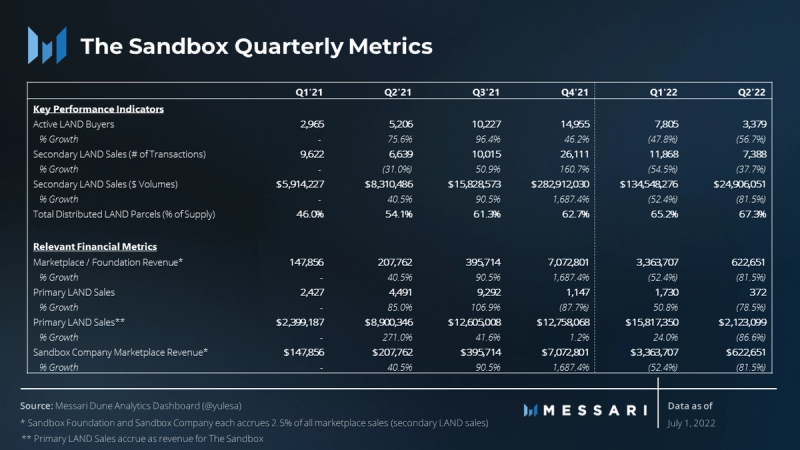
A Primer on The Sandbox
The Sandbox is a platform for both creating and hosting entertainment experiences in virtual worlds. In The Sandbox, anyone can create 3D assets like buildings, in-game items, and non-player characters. These assets can then be used to build diverse experiences including games, music and fashion events, social activities, quests, art exhibits, and contests. The Sandbox offers creators a set of intuitive tools that require no background in coding or in designing experiences. These tools include a 3D editor for making and animating items, a game maker for making experiences, and a game client. The Sandbox is actively working on making these tools as user-friendly as possible in order to unleash the creativity of its community. For instance, the 3D editor combines different in-game tokens to create user-generated assets.
These user-generated assets are ERC-721 non-fungible tokens that can be monetized on open markets. The Sandbox ecosystem leverages a series of tokenized gaming features including:
- a digital in-game currency used for purchases, monetization, and asset creation (i.e., SAND);
- ownable digital land within The Sandbox virtual world (LAND);
- a combination of LANDs to create a larger plot (ESTATE);
- a bundle of assets and scripting logic to create interactive experiences (GAMES);
- 3D virtual images created by players (ASSETS); tokens burnt to give attributes to assets (GEMS); and
- tokens burnt to create ASSETS (CATALYSTS).
Thanks to the tradeable nature of these user-generated assets within its virtual world, The Sandbox has robust in-game economics.
Performance Analysis
LAND Parcel Distribution
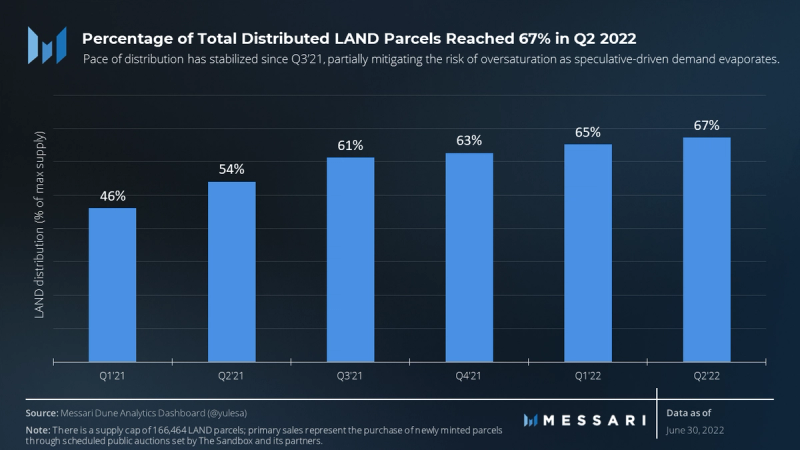
There is a finite amount of LAND in The Sandbox — 166,464 parcels. New LAND parcels are minted (primary sales) through publicly scheduled minting events (fixed price or English Auction). Private sales to partner projects also take place. LAND is typically sold on a first-come-first-serve basis, with prices announced through a blog post ahead of each event. Prices also vary based on rarity (regular vs. Premium) and larger ESTATES are often auctioned on Opensea.
- The proportion of LAND parcels that have been distributed has increased to 67% of the maximum supply in Q2 2022, up 2% QoQ.
- This gradual ~2% pace has remained relatively stable since Q3 ‘21 and a notable downshift from the >5% quarterly LAND distributions that occurred in 2020 through mid-2021.
The Sandbox team’s management of new land sales likely comes as a welcomed move by current land holders, who may have concerns about oversaturation of LAND supplies on the open market at a time when demand has taken a decisive step back.
LAND Primary Sales (Public Auction Mints)
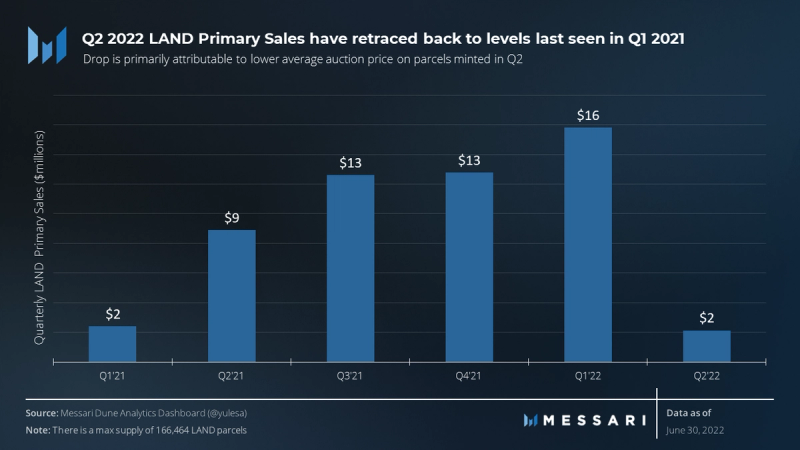
The Sandbox recorded $2.1 million in primary LAND sales volume on 3,554 parcels minted in Q2 ‘22. This took place over two public mints on April 7 (Shibuya) and April 28 (Mega City 2). Q2 2022 marks the lowest volume (in USD) seen in over 15 months and represents a sharp 87% retracement from the $16 million peak in primary sales achieved in the prior quarter.
Average sales price during the latest public auctions of LAND parcels fell to a more modest ~$597 per unit, down from ~$5,633 average price experienced during the Q4‘21 investor euphoria and near the $667 average price paid for plots during the Q2’21 public sales. The subject of primary sales are LAND parcels that are newly issued and are usually either sold to partners or through public auctions. With that said, primary LAND sales volume ($2 million) is notably smaller than the $25 million in marketplace secondary sales volume.
Secondary Sales Volume
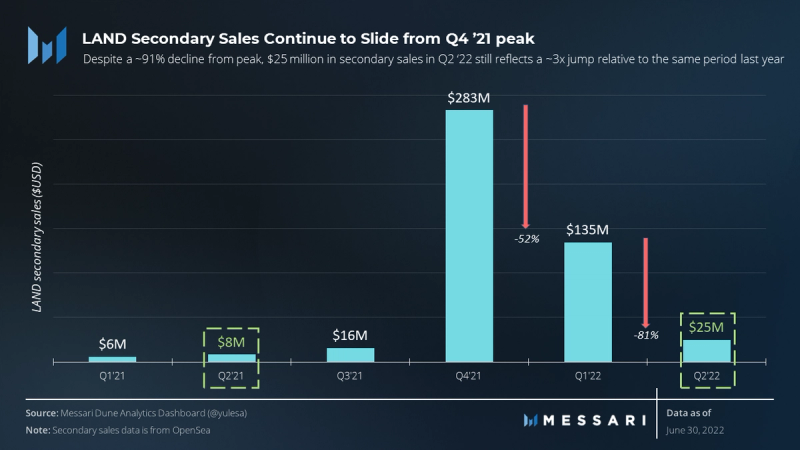
The vast majority of USD volumes are attributable to secondary sales of land parcels. Secondary sales peaked at $283 million in Q4 2021, followed by a 91% retracement over the two consecutive quarters since. With secondary sale volumes standing at just $1.2 million in Q4‘20, the >225x rise in 2021 came amidst investor euphoria across NFT markets. Sandbox secondary sales volumes reached a fever pitch in November 2021 shortly after Facebook rebranded to Meta — effectively marking the top of the bull cycle in Q4‘21. Through the first half of 2022, Sandbox secondary sales have experienced a 91% decline from the peak, down to $25 million in Q2 ’22 (~81% decline QoQ compared to Q1‘22). Despite the significant pullback in volumes, the Q2‘22 secondary sales figure represents a >3x increase in just a 12 month span (compared to $8 million in Q2‘21) — an impressive feat nonetheless.
The Sandbox Foundation and Sandbox Company each accrue 2.5% of all secondary marketplace sales. In the latest quarter, this fee translated to ~$1.2 million in total revenue accrual for the organizations ($622,651 each), down from the $6.7 million in total fee revenue captured in Q1‘22 (mirroring the 81% QoQ decline in secondary sales volumes). As with its secondary sales volumes, the platform could still record a 3x growth in fee revenues YoY, up from the $415,524 total garnered in Q2 ‘21. As with most things in crypto, “zooming out” helps put things in perspective.
Network Activity
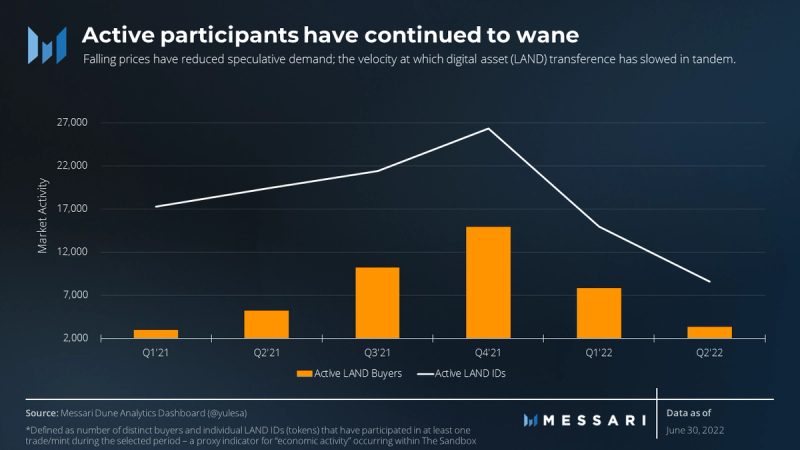
Network Activity
The number of distinct wallets purchasing land (“Active LAND Buyers”) has continued to trend lower, reaching 3,379 buyers in Q2‘22. The 57% QoQ decrease from the 7,805 active buyers recorded in Q1 ‘22 is a 12 month low and well-below the 14,955 distinct wallet addresses recorded during the Q4‘21 peak. Similarly, the number of distinct land parcels changing ownership has also diminished during this period (down 43% QoQ).
Given the lack of publicly available in-game player data, active buyers and land transfers act as a proxy for general network activity. A challenging macro environment has driven a deep decline in investor sentiment across broader crypto and global markets, quelling the rampant speculation seen at the end of 2021. Market participants have generally become more hesitant to take on additional exposure to risk assets, and transaction volumes have slowed, as would be expected.
“Land Flipping” Profitability
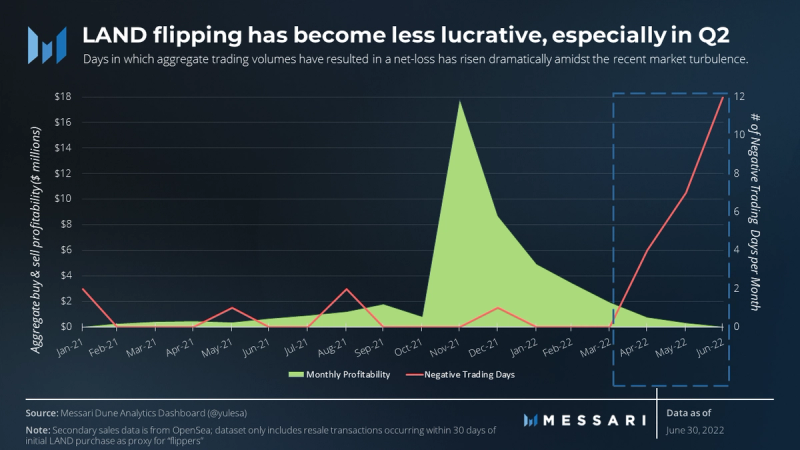
Peak profit taking occurred on Nov. 24, 2021 — roughly one month after the Meta rebrand announcement. Since then, traders have seen a rapid decline in aggregate profits. Additionally, between January 2020 through all of 2021, traders only witnessed 19 days where aggregate land sales resulted in a loss (Dec. 31, 2021, having the largest negative balance). In just the first 6 months of 2022, however, traders have experienced 23 days of aggregate losses. In other words, land flipping has become much less of a “sure thing” as markets have soured globally.
The case for digital land is still in its early days in terms of the building of experiences. Intuitively, making immersive experiences available in The Sandbox may be a potential catalyst for sustainable value creation and capture.
In this sense, users are eagerly awaiting immersive crypto-consumer gameplay experiences to be launched. Creators are well positioned to build immersive virtual experiences and make them available for users. In terms of capturing that value, owners may acquire specific LAND parcels with the hope that hosting virtual experiences on those parcels may, in turn, drive increased user activity. This could further create aflywheel for immersive experiences to be adopted on a large-scale, which, in turn, would boost the value of LAND parcels over the long-term.
However, it is not presently possible for creators to make experiences available to others using LAND parcels, which may hinder real demand for the time being. While most LAND buyers may be initially inclined to hold, the absence of practical means to monetize in the near-term may ultimately lead to heightened profit taking. To maintain its current trajectory, The Sandbox must continue building the backbone upon which an immersive metaverse experience can grow.
Qualitative Analysis
The Sandbox Ecosystem: Notable Events
Partnerships & Integrations
It seems like an endless line of brands has formed at the gates of The Sandbox, and they continue to march one-by-one into The Sandbox ecosystem, taking their first steps into “the metaverse.” Driven by the vast possibilities of building and monetizing digital experiences, many well-known organizations have announced partnerships with The Sandbox across various industry verticals. In Q2 2022, notable entrants to the ecosystem include:
- Gaming: GamerHash (pooled computing power ecosystem and gaming studio) and ICONIX Animation Studio (building a virtual theme park game based off their Pororo animation show IP)
- Music: KNOTVERSE (Slipknot and Knotfest partnership) and “Rugged Festival” NFT collection (for building music festival experiences on Sandbox Land)
- Entertainment: RLTY (live virtual event architecture platform) and LOTTE WORLD Adventure (the world’s largest indoor amusement park plans to expand to the metaverse)
- Diversity and Inclusion: CJ ENM (leading diversity and inclusion content company creating culture and trends)
- Fashion and Lifestyle: The Council of Fashion Designers of America (CFDA) and The Museum of Contemporary Digital Art (MoCDA)
- Infrastructure: MTR Corporation (a global rail transport operator planning to build a rail system in The Sandbox)
Developing further partnerships will remain a focus area for The Sandbox for the foreseeable future. Additionally, Sandbox announced integration with the Coinbase Wallet client to interact with its platform (previously, MetaMask was the only wallet client available).
Acquisition of Cualit Gaming Technology Firm
Sandbox announced the acquisition of the Uruguayan company Cualit, a full-stack development technology firm experienced in gaming, to boost its Web3 and blockchain innovation and development capabilities. Cualit will be rebranded as “The Sandbox Uruguay” and will be considered Sandbox’s second development office in South America, alongside the existing dev office in Argentina.
LAND and SAND deployment on Polygon / mSAND Claim for LAND owners
As of June 29, The Sandbox announced the successful deployment of the LAND and SAND smart contracts on Polygon, achieving another milestone on the gaming platform’s path to fully transition to Layer 2. Both LAND and SAND are now fully supported on Polygon’s network and a specialty bridge has been made available, which users are encouraged to use to transfer their assets. Users will receive a 10 mSAND “cashback” bonus sent to their Polygon wallets once they’ve successfully bridged over their first Sandbox asset.
Additionally, a snapshot was taken on May 13 that unlocked 5 million mSAND on the Polygon Network, which will be distributed proportionally across LAND owners. Land owners can claim their mSAND on the Sandbox website.
This news comes after the Sandbox introduced gasless mSAND staking in February, which enabled a seamless single-sided staking experience on Polygon.
Roadmap
Full Transition to Layer 2
In an effort to promote sustainable, more affordable participation in the ecosystem, the following features are expected to transition to Polygon over the coming year:
- LAND sales on Polygon (the next public minting event will be held on Polygon)
- LAND staking features
- ASSET smart contract to be deployed/bridged
open ASSET minting contract to be deployed - ESTATE creation and modification
- Experience publishing on LAND through Polygon
Looking ahead, The Sandbox has a few notable developments in the pipeline.
Progressive Decentralization
Through progressive decentralization paired with digital asset ownership, The Sandbox aims to incentivize its community to build their own experiences and, ultimately, foster the next generation of massive video game franchises. While not yet deployed, The Sandbox DAO will be able to vote on Foundation grants as well as make decisions on game developments. The Sandbox DAO will be governed by both SAND tokenholders and LAND owners.
Sandbox Alpha Season 3
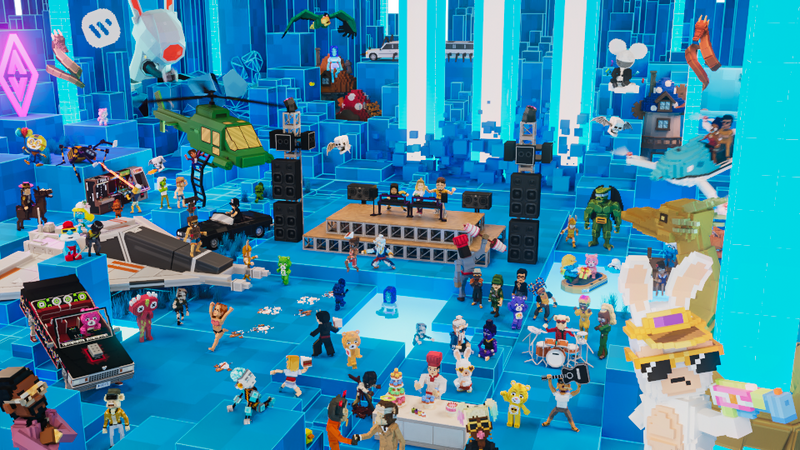
Source: The Sandbox
On April 30, Sandbox announced preparations have commenced for the third installment of its Alpha test. After a successful Season 2, which welcomed 325,000 alpha participants and saw 700,000 players interact with its social contests, the Sandbox Team is laying the groundwork for an even more immersive experience in Season 3 (additional event details expected to be released in July.
Enhanced Land Functionality
Currently, in-game experiences on land parcels are limited in scope and availability, but there are plans to gradually roll out greater functionality as development of The Sandbox continues. In fact, at the core of the investment thesis behind LAND speculation sits the expectation that one day landowners will be able to monetize their parcels via in-game experiences. This aligns with The Sandbox’s stated long-term goal of enabling creators to build immersive experiences.
The top owners of LAND include large investors in The Sandbox, such as Binance, Everyrealm, and Galaxy Interactive, prominent NFT collectors such as WhaleShark and MetaKovan, along with well-known NFT communities like Cyber Kongz.
Closing Summary
Despite far from ideal market conditions, The Sandbox continued to deliver on its promise to build a robust metaverse for its increasingly diverse community. It only takes a bit of “zooming out” to see the clear positives to Sandbox’s financial picture. Few platforms can survive secondary sales volume declining >90% and still tout 300% YoY growth on that very same metric. And, as is often the case, the mass exodus of speculators may ultimately be the healthiest thing for the platform. Bear markets are for building the next bull market.
With that said, The Sandbox’s revenue model Sandbox should continue to incentivize the community to build a robust ecosystem powered by network effects. Because revenues are effectively a function of the economic activity spurred within the borders of its network — the 5% cumulative fee on secondary sales act as a sales tax — a path to sustainable growth is in every stakeholder’s best interest. It’s still early days for the platform, and Sandbox is likely to see continued growth in its community and, subsequently, its revenues over the long term.
With its status as a market leader in the space and backing from some of the most prominent funds active in crypto, The Sandbox’s ecosystem is on a clear path to success, irrespective of the short-term market volatility.
Looking to dive deeper? Subscribe to Messari Pro. Messari Pro memberships provide access to daily crypto news and insights, exclusive long-form daily research, advanced screener, charting & watchlist features, and access to curated sets of charts and metrics. Learn more at messari.io/pro
This report was commissioned by The Sandbox, a member of Protocol Services. All content was produced independently by the author(s) and does not necessarily reflect the opinions of Messari, Inc. or the organization that requested the report. Paid membership in Protocol Services does not influence editorial decision or content. Author(s) may hold cryptocurrencies named in this report.
Crypto projects can commission independent research through Protocol Services. For more details or to join the program, contact ps@messari.io.
This report is meant for informational purposes only. It is not meant to serve as investment advice. You should conduct your own research, and consult an independent financial, tax, or legal advisor before making any investment decisions. Past performance of any asset is not indicative of future results. Please see our terms of use for more information.



















